The Intel Core i3-7350K (60W) Review: Almost a Core i7-2600K
by Ian Cutress on February 3, 2017 8:00 AM ESTProfessional Performance: Windows
Agisoft Photoscan – 2D to 3D Image Manipulation: link
Agisoft Photoscan creates 3D models from 2D images, a process which is very computationally expensive. The algorithm is split into four distinct phases, and different phases of the model reconstruction require either fast memory, fast IPC, more cores, or even OpenCL compute devices to hand. Agisoft supplied us with a special version of the software to script the process, where we take 50 images of a stately home and convert it into a medium quality model. This benchmark typically takes around 15-20 minutes on a high-end PC on the CPU alone, with GPUs reducing the time.
Here we report the overall time to complete the test – sub-test results can be found in Bench.
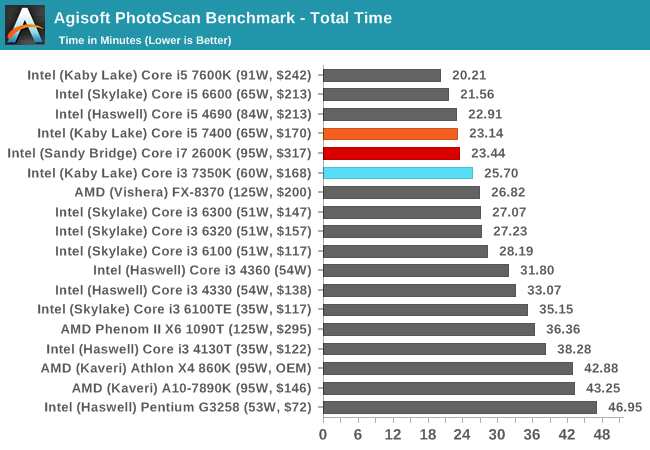
Photoscan is a mix of single and multi-threaded segments, but overall the extra cores in the i5/i7 beat the Core i3, but not by much.
Cinebench R15
Cinebench is a benchmark based around Cinema 4D, and is fairly well known among enthusiasts for stressing the CPU for a provided workload. Results are given as a score, where higher is better.
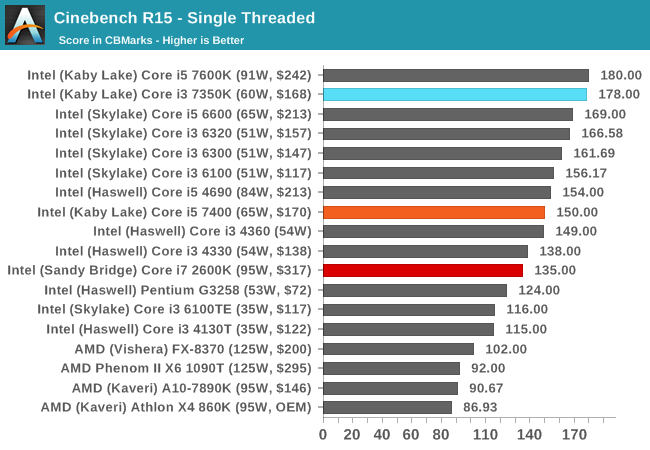
All the Kaby Lake processors seem to do well in CB15 single threaded performance, given that all the K-processors can reach 4.2 GHz or higher one way or another. Nonetheless, the age of the Core i7-2600K is showing here.
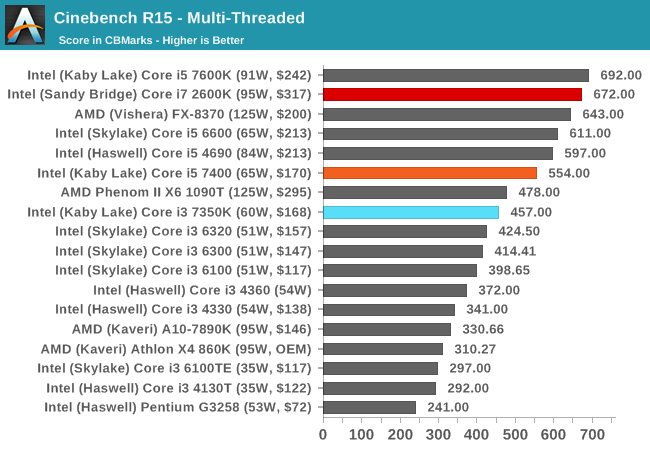
Turning the tables with actual cores, and the Core i7-2600K gets a significant leg up here. The Core i5 also sits above the Core i3.
HandBrake v0.9.9: link
For HandBrake, we take two videos (a 2h20 640x266 DVD rip and a 10min double UHD 3840x4320 animation short) and convert them to x264 format in an MP4 container. Results are given in terms of the frames per second processed, and HandBrake uses as many threads as possible.
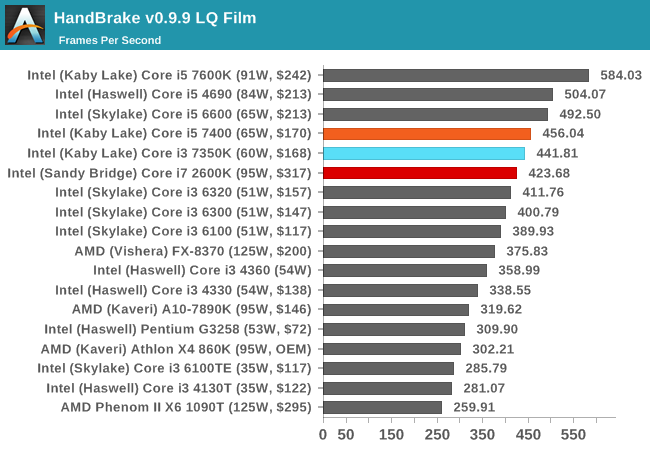

For video conversion, having small frames puts all three CPUs in a similar spot. But ramp up the frame size and we see the Kaby Lake i5 pull ahead due to IPC and instructions. The Core i3 has enough oomph to match the extra threads on the Core i7-2600K though.
Hybrid x265
Hybrid is a new benchmark, where we take a 4K 1500 frame video and convert it into an x265 format without audio. Results are given in frames per second.
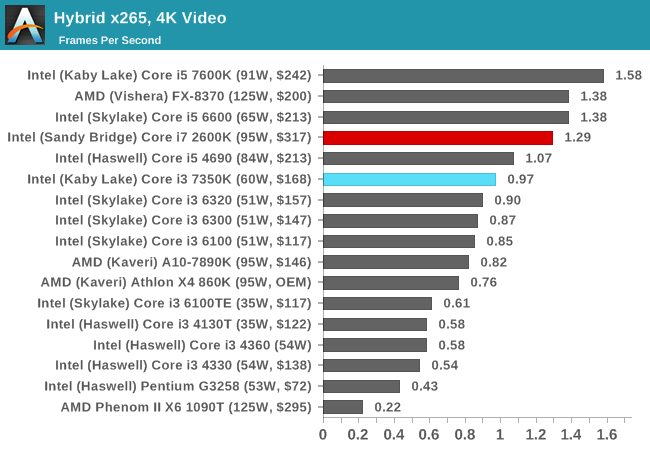
With a different video conversion tool and render, the extra cores and threads of the Core i7 is more than enough to give it a 30% advantage over the Core i3-7350K. It makes me wonder if another +30% frequency would help the Core i3.










186 Comments
View All Comments
cknobman - Friday, February 3, 2017 - link
I definitely think they should have at least included those results.fanofanand - Friday, February 3, 2017 - link
Some people purchase a "K" processor for the binning, not to overclock it.JackNSally - Friday, February 3, 2017 - link
Ok. So exclude those that buy it to overclock?fanofanand - Sunday, February 5, 2017 - link
I was responding to the comment saying the only reason to get a k was to overclock.WithoutWeakness - Friday, February 3, 2017 - link
Absolutely should have included overclocking. Sandy Bridge chips had very conservative stock clocks and great overclocking potential. At the time you were almost guaranteed 4.4GHz-4.7GHz on air and and there were lucky users reaching 4.8-5GHz (and more under water). My 2600K has been running stable at 4.6GHz (a 35% overclock) for six years now at 1.35v. Those single-threaded charts would look much different if you included overclocks and the multi-threaded charts would seriously widen the gap.I'm glad Intel has opened the gates for overclocking i3's but this review really just shows how small Intel's gains have been in the last six years. I'm hoping Ryzen brings some serious performance to the table (especially at the high end) and lights a fire under Intel's asses. Better iGPUs and lower power consumption are great for laptops and and basic users's needs but there has been no innovation in the HEDT market for many years unless you're willing to shell out $1700 for the 10-core Extreme Edition.
CaedenV - Friday, February 3, 2017 - link
Yep! Sandy Bridge was/is good tech!I got the non-K i7 Sandy Bridge, and even that overclocked easy to 4.2GHz. It was an artificial limit, but I didn't need to spend the $50 premium to get a potential 3-500MHz out of it. Been humming along for 6 years now and hasn't missed a beat!
At this rate I will probably be 'upgrading' my game rig to a tiny little i3, and recycling my i7 as a home server for storage and VMs.
eldakka - Sunday, February 5, 2017 - link
"(and more under water)"Shocking.
dragosmp - Friday, February 3, 2017 - link
Agreed, Ian might have posted them. Still, read between the lines: there is a statement the 2600K does 4.8-5GHz. At 20% higher clock speed, the 2600K destroys the OCed i3 7350K, no contest. It may consume 4x the power, but dunno, do you care when the GPU consumes 5x more anyway?CaedenV - Friday, February 3, 2017 - link
Ya, not too useful on the gaming charts as even the non-K chips kept up with the GPUs just fine. But getting to see what it does for productivity tasks would be interesting.Actually, stock vs OC i3, i5, i7, and i7 Sandy would be very interesting to me.
dave_the_nerd - Friday, February 3, 2017 - link
Too much individual variation. Non-overclocked performance is the guarantee. Everything else is up to chance in the silicon lottery.Also potential for abuse: say, the manufacturer sends reviewers some golden sample that hits 5.1GHz on air. Hah! GPU makers used to pull stunts like that.